Strategic HRM Issues and Solutions: Lion Nathan Case Study Analysis
VerifiedAdded on 2022/11/28
|10
|3208
|309
Report
AI Summary
This report provides a comprehensive analysis of Lion Nathan's strategic human resource management (SHRM) practices. It examines the HRM issues faced by the Australian beverage company, including recruitment challenges, low employee retention, and performance problems, which led to significant financial losses in 2015. The report details how Lion Nathan implemented SHRM to address these issues, focusing on improving recruitment processes, aligning employee goals with business objectives, and enhancing workplace culture and job satisfaction. The analysis highlights the measures taken, such as the implementation of a checklist for applicants, induction programs, reward and recognition systems, and performance management. The outcomes of these changes are also discussed, showcasing how SHRM helped Lion Nathan improve its financial performance, increase its employee base, and strengthen its market share in the alcoholic beverage industry. The report concludes by emphasizing the importance of strategic HRM in achieving long-term growth and competitive advantage.
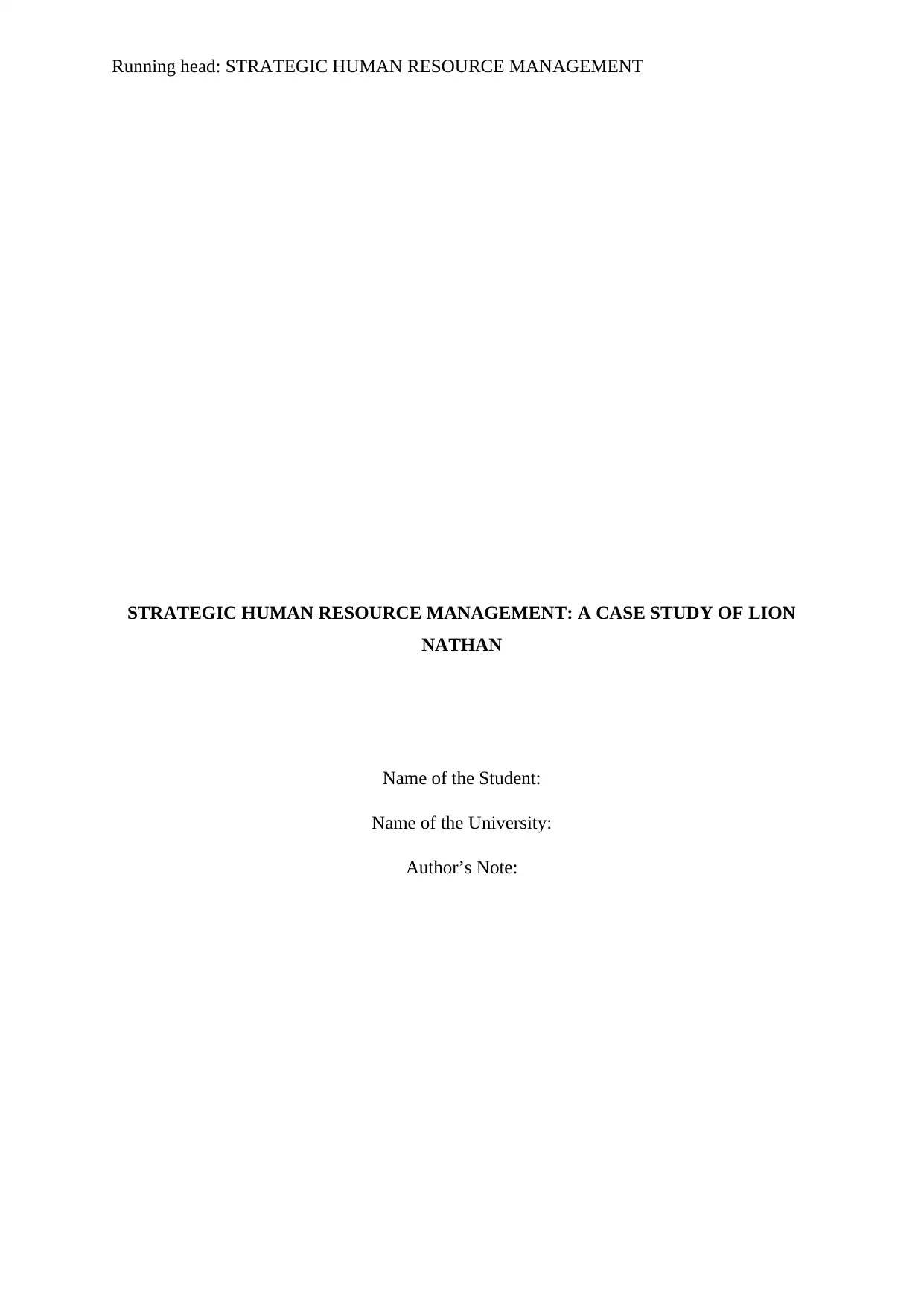
Running head: STRATEGIC HUMAN RESOURCE MANAGEMENT
STRATEGIC HUMAN RESOURCE MANAGEMENT: A CASE STUDY OF LION
NATHAN
Name of the Student:
Name of the University:
Author’s Note:
STRATEGIC HUMAN RESOURCE MANAGEMENT: A CASE STUDY OF LION
NATHAN
Name of the Student:
Name of the University:
Author’s Note:
Paraphrase This Document
Need a fresh take? Get an instant paraphrase of this document with our AI Paraphraser
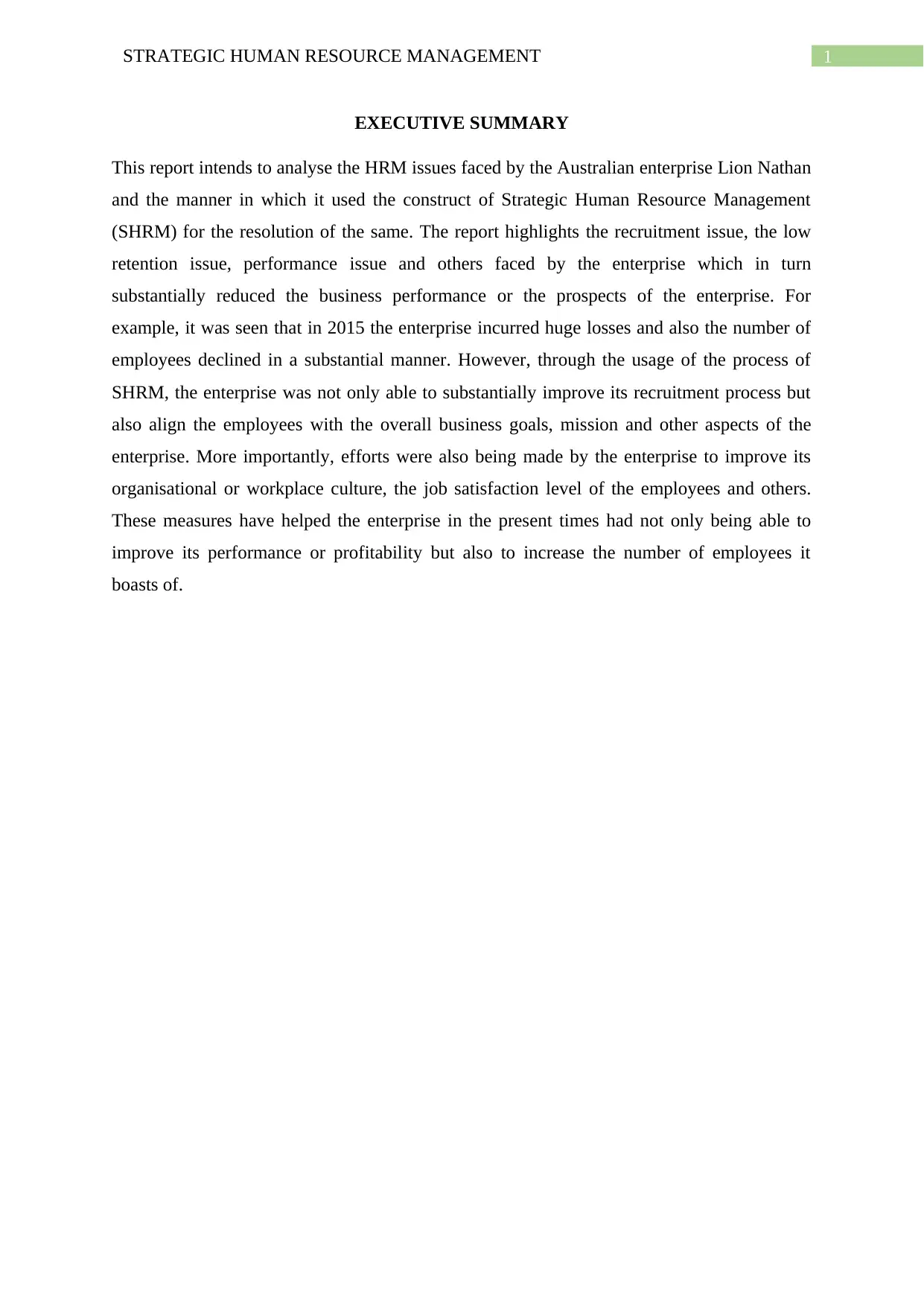
1STRATEGIC HUMAN RESOURCE MANAGEMENT
EXECUTIVE SUMMARY
This report intends to analyse the HRM issues faced by the Australian enterprise Lion Nathan
and the manner in which it used the construct of Strategic Human Resource Management
(SHRM) for the resolution of the same. The report highlights the recruitment issue, the low
retention issue, performance issue and others faced by the enterprise which in turn
substantially reduced the business performance or the prospects of the enterprise. For
example, it was seen that in 2015 the enterprise incurred huge losses and also the number of
employees declined in a substantial manner. However, through the usage of the process of
SHRM, the enterprise was not only able to substantially improve its recruitment process but
also align the employees with the overall business goals, mission and other aspects of the
enterprise. More importantly, efforts were also being made by the enterprise to improve its
organisational or workplace culture, the job satisfaction level of the employees and others.
These measures have helped the enterprise in the present times had not only being able to
improve its performance or profitability but also to increase the number of employees it
boasts of.
EXECUTIVE SUMMARY
This report intends to analyse the HRM issues faced by the Australian enterprise Lion Nathan
and the manner in which it used the construct of Strategic Human Resource Management
(SHRM) for the resolution of the same. The report highlights the recruitment issue, the low
retention issue, performance issue and others faced by the enterprise which in turn
substantially reduced the business performance or the prospects of the enterprise. For
example, it was seen that in 2015 the enterprise incurred huge losses and also the number of
employees declined in a substantial manner. However, through the usage of the process of
SHRM, the enterprise was not only able to substantially improve its recruitment process but
also align the employees with the overall business goals, mission and other aspects of the
enterprise. More importantly, efforts were also being made by the enterprise to improve its
organisational or workplace culture, the job satisfaction level of the employees and others.
These measures have helped the enterprise in the present times had not only being able to
improve its performance or profitability but also to increase the number of employees it
boasts of.
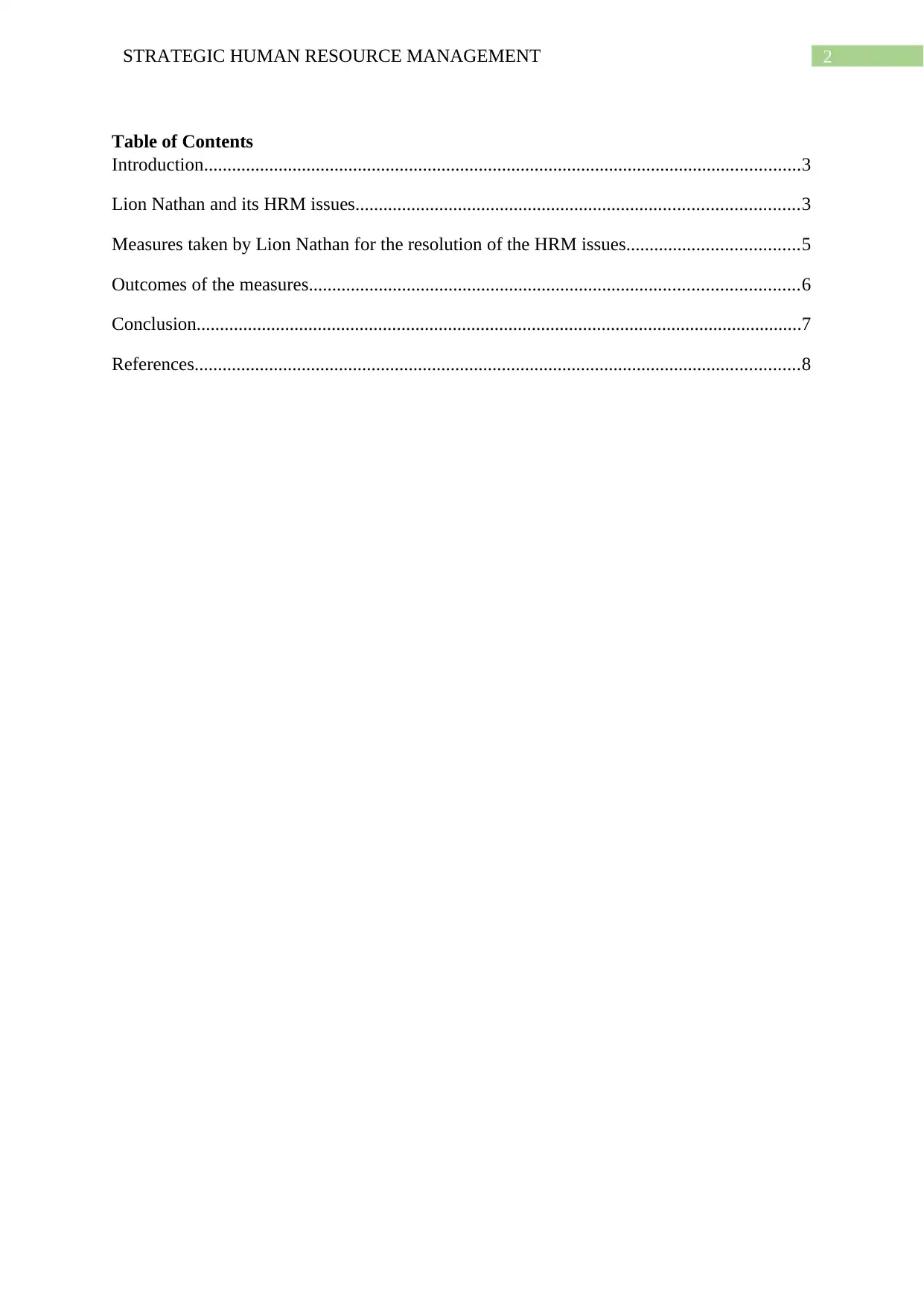
2STRATEGIC HUMAN RESOURCE MANAGEMENT
Table of Contents
Introduction................................................................................................................................3
Lion Nathan and its HRM issues...............................................................................................3
Measures taken by Lion Nathan for the resolution of the HRM issues.....................................5
Outcomes of the measures.........................................................................................................6
Conclusion..................................................................................................................................7
References..................................................................................................................................8
Table of Contents
Introduction................................................................................................................................3
Lion Nathan and its HRM issues...............................................................................................3
Measures taken by Lion Nathan for the resolution of the HRM issues.....................................5
Outcomes of the measures.........................................................................................................6
Conclusion..................................................................................................................................7
References..................................................................................................................................8
⊘ This is a preview!⊘
Do you want full access?
Subscribe today to unlock all pages.

Trusted by 1+ million students worldwide
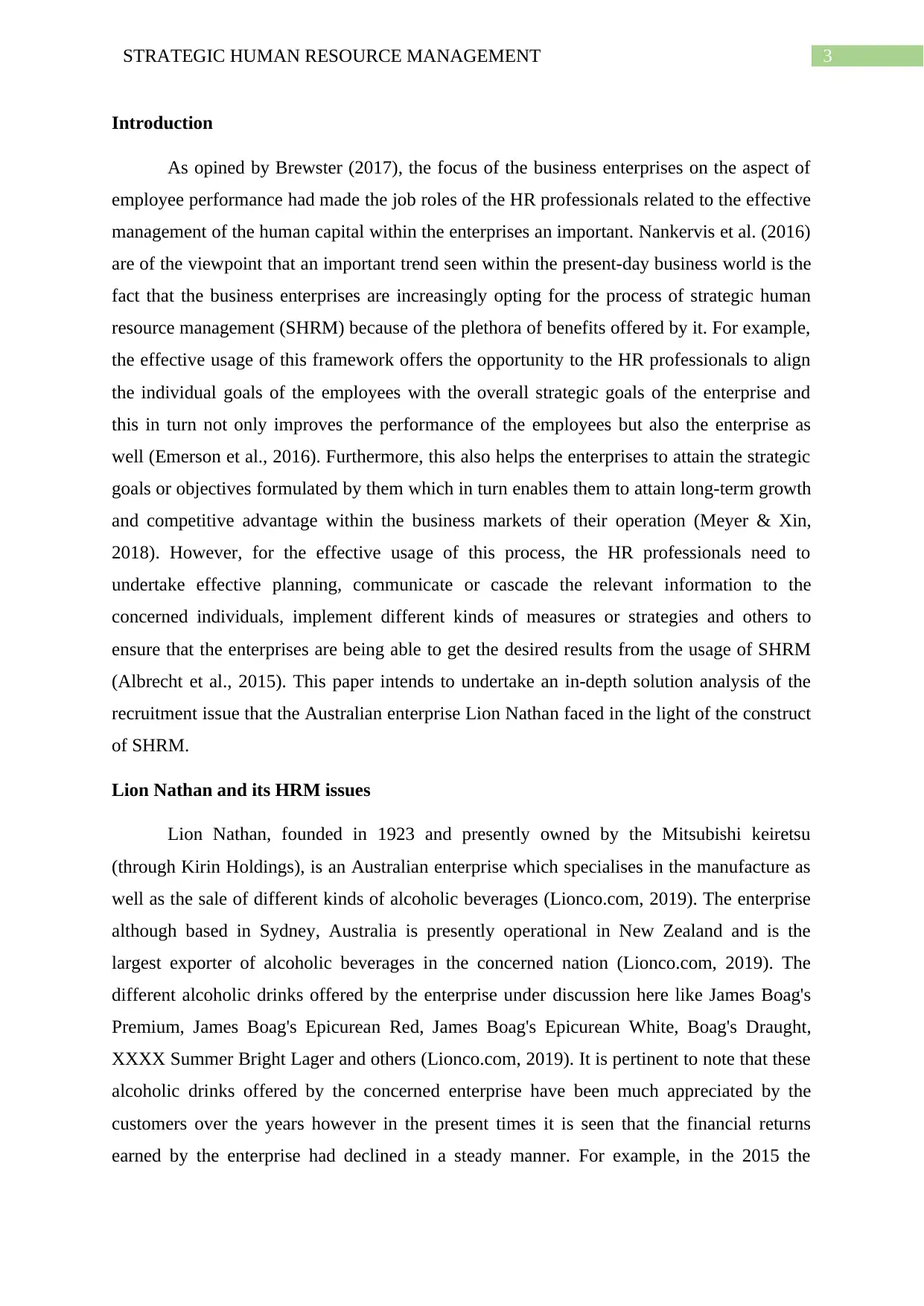
3STRATEGIC HUMAN RESOURCE MANAGEMENT
Introduction
As opined by Brewster (2017), the focus of the business enterprises on the aspect of
employee performance had made the job roles of the HR professionals related to the effective
management of the human capital within the enterprises an important. Nankervis et al. (2016)
are of the viewpoint that an important trend seen within the present-day business world is the
fact that the business enterprises are increasingly opting for the process of strategic human
resource management (SHRM) because of the plethora of benefits offered by it. For example,
the effective usage of this framework offers the opportunity to the HR professionals to align
the individual goals of the employees with the overall strategic goals of the enterprise and
this in turn not only improves the performance of the employees but also the enterprise as
well (Emerson et al., 2016). Furthermore, this also helps the enterprises to attain the strategic
goals or objectives formulated by them which in turn enables them to attain long-term growth
and competitive advantage within the business markets of their operation (Meyer & Xin,
2018). However, for the effective usage of this process, the HR professionals need to
undertake effective planning, communicate or cascade the relevant information to the
concerned individuals, implement different kinds of measures or strategies and others to
ensure that the enterprises are being able to get the desired results from the usage of SHRM
(Albrecht et al., 2015). This paper intends to undertake an in-depth solution analysis of the
recruitment issue that the Australian enterprise Lion Nathan faced in the light of the construct
of SHRM.
Lion Nathan and its HRM issues
Lion Nathan, founded in 1923 and presently owned by the Mitsubishi keiretsu
(through Kirin Holdings), is an Australian enterprise which specialises in the manufacture as
well as the sale of different kinds of alcoholic beverages (Lionco.com, 2019). The enterprise
although based in Sydney, Australia is presently operational in New Zealand and is the
largest exporter of alcoholic beverages in the concerned nation (Lionco.com, 2019). The
different alcoholic drinks offered by the enterprise under discussion here like James Boag's
Premium, James Boag's Epicurean Red, James Boag's Epicurean White, Boag's Draught,
XXXX Summer Bright Lager and others (Lionco.com, 2019). It is pertinent to note that these
alcoholic drinks offered by the concerned enterprise have been much appreciated by the
customers over the years however in the present times it is seen that the financial returns
earned by the enterprise had declined in a steady manner. For example, in the 2015 the
Introduction
As opined by Brewster (2017), the focus of the business enterprises on the aspect of
employee performance had made the job roles of the HR professionals related to the effective
management of the human capital within the enterprises an important. Nankervis et al. (2016)
are of the viewpoint that an important trend seen within the present-day business world is the
fact that the business enterprises are increasingly opting for the process of strategic human
resource management (SHRM) because of the plethora of benefits offered by it. For example,
the effective usage of this framework offers the opportunity to the HR professionals to align
the individual goals of the employees with the overall strategic goals of the enterprise and
this in turn not only improves the performance of the employees but also the enterprise as
well (Emerson et al., 2016). Furthermore, this also helps the enterprises to attain the strategic
goals or objectives formulated by them which in turn enables them to attain long-term growth
and competitive advantage within the business markets of their operation (Meyer & Xin,
2018). However, for the effective usage of this process, the HR professionals need to
undertake effective planning, communicate or cascade the relevant information to the
concerned individuals, implement different kinds of measures or strategies and others to
ensure that the enterprises are being able to get the desired results from the usage of SHRM
(Albrecht et al., 2015). This paper intends to undertake an in-depth solution analysis of the
recruitment issue that the Australian enterprise Lion Nathan faced in the light of the construct
of SHRM.
Lion Nathan and its HRM issues
Lion Nathan, founded in 1923 and presently owned by the Mitsubishi keiretsu
(through Kirin Holdings), is an Australian enterprise which specialises in the manufacture as
well as the sale of different kinds of alcoholic beverages (Lionco.com, 2019). The enterprise
although based in Sydney, Australia is presently operational in New Zealand and is the
largest exporter of alcoholic beverages in the concerned nation (Lionco.com, 2019). The
different alcoholic drinks offered by the enterprise under discussion here like James Boag's
Premium, James Boag's Epicurean Red, James Boag's Epicurean White, Boag's Draught,
XXXX Summer Bright Lager and others (Lionco.com, 2019). It is pertinent to note that these
alcoholic drinks offered by the concerned enterprise have been much appreciated by the
customers over the years however in the present times it is seen that the financial returns
earned by the enterprise had declined in a steady manner. For example, in the 2015 the
Paraphrase This Document
Need a fresh take? Get an instant paraphrase of this document with our AI Paraphraser
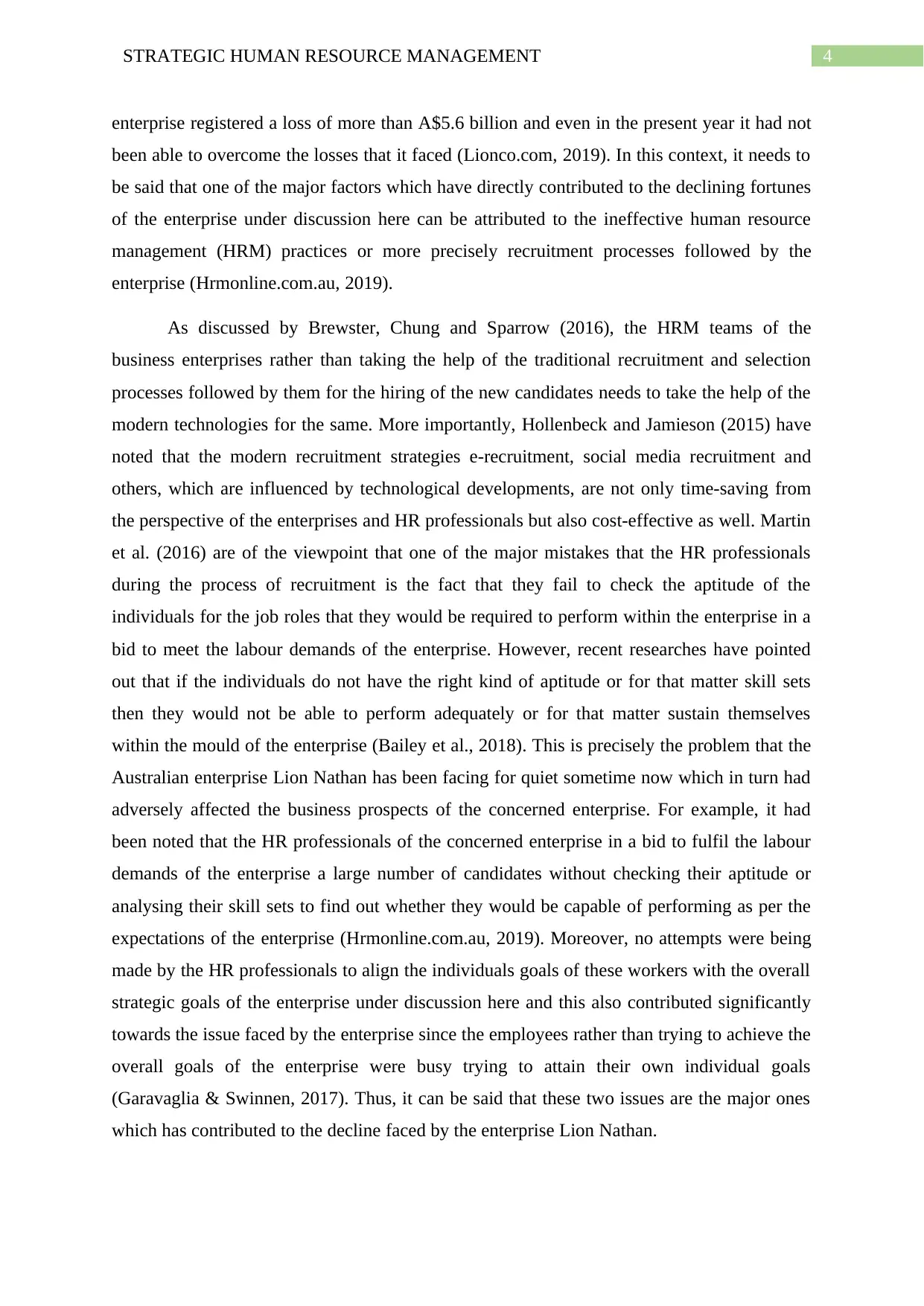
4STRATEGIC HUMAN RESOURCE MANAGEMENT
enterprise registered a loss of more than A$5.6 billion and even in the present year it had not
been able to overcome the losses that it faced (Lionco.com, 2019). In this context, it needs to
be said that one of the major factors which have directly contributed to the declining fortunes
of the enterprise under discussion here can be attributed to the ineffective human resource
management (HRM) practices or more precisely recruitment processes followed by the
enterprise (Hrmonline.com.au, 2019).
As discussed by Brewster, Chung and Sparrow (2016), the HRM teams of the
business enterprises rather than taking the help of the traditional recruitment and selection
processes followed by them for the hiring of the new candidates needs to take the help of the
modern technologies for the same. More importantly, Hollenbeck and Jamieson (2015) have
noted that the modern recruitment strategies e-recruitment, social media recruitment and
others, which are influenced by technological developments, are not only time-saving from
the perspective of the enterprises and HR professionals but also cost-effective as well. Martin
et al. (2016) are of the viewpoint that one of the major mistakes that the HR professionals
during the process of recruitment is the fact that they fail to check the aptitude of the
individuals for the job roles that they would be required to perform within the enterprise in a
bid to meet the labour demands of the enterprise. However, recent researches have pointed
out that if the individuals do not have the right kind of aptitude or for that matter skill sets
then they would not be able to perform adequately or for that matter sustain themselves
within the mould of the enterprise (Bailey et al., 2018). This is precisely the problem that the
Australian enterprise Lion Nathan has been facing for quiet sometime now which in turn had
adversely affected the business prospects of the concerned enterprise. For example, it had
been noted that the HR professionals of the concerned enterprise in a bid to fulfil the labour
demands of the enterprise a large number of candidates without checking their aptitude or
analysing their skill sets to find out whether they would be capable of performing as per the
expectations of the enterprise (Hrmonline.com.au, 2019). Moreover, no attempts were being
made by the HR professionals to align the individuals goals of these workers with the overall
strategic goals of the enterprise under discussion here and this also contributed significantly
towards the issue faced by the enterprise since the employees rather than trying to achieve the
overall goals of the enterprise were busy trying to attain their own individual goals
(Garavaglia & Swinnen, 2017). Thus, it can be said that these two issues are the major ones
which has contributed to the decline faced by the enterprise Lion Nathan.
enterprise registered a loss of more than A$5.6 billion and even in the present year it had not
been able to overcome the losses that it faced (Lionco.com, 2019). In this context, it needs to
be said that one of the major factors which have directly contributed to the declining fortunes
of the enterprise under discussion here can be attributed to the ineffective human resource
management (HRM) practices or more precisely recruitment processes followed by the
enterprise (Hrmonline.com.au, 2019).
As discussed by Brewster, Chung and Sparrow (2016), the HRM teams of the
business enterprises rather than taking the help of the traditional recruitment and selection
processes followed by them for the hiring of the new candidates needs to take the help of the
modern technologies for the same. More importantly, Hollenbeck and Jamieson (2015) have
noted that the modern recruitment strategies e-recruitment, social media recruitment and
others, which are influenced by technological developments, are not only time-saving from
the perspective of the enterprises and HR professionals but also cost-effective as well. Martin
et al. (2016) are of the viewpoint that one of the major mistakes that the HR professionals
during the process of recruitment is the fact that they fail to check the aptitude of the
individuals for the job roles that they would be required to perform within the enterprise in a
bid to meet the labour demands of the enterprise. However, recent researches have pointed
out that if the individuals do not have the right kind of aptitude or for that matter skill sets
then they would not be able to perform adequately or for that matter sustain themselves
within the mould of the enterprise (Bailey et al., 2018). This is precisely the problem that the
Australian enterprise Lion Nathan has been facing for quiet sometime now which in turn had
adversely affected the business prospects of the concerned enterprise. For example, it had
been noted that the HR professionals of the concerned enterprise in a bid to fulfil the labour
demands of the enterprise a large number of candidates without checking their aptitude or
analysing their skill sets to find out whether they would be capable of performing as per the
expectations of the enterprise (Hrmonline.com.au, 2019). Moreover, no attempts were being
made by the HR professionals to align the individuals goals of these workers with the overall
strategic goals of the enterprise under discussion here and this also contributed significantly
towards the issue faced by the enterprise since the employees rather than trying to achieve the
overall goals of the enterprise were busy trying to attain their own individual goals
(Garavaglia & Swinnen, 2017). Thus, it can be said that these two issues are the major ones
which has contributed to the decline faced by the enterprise Lion Nathan.
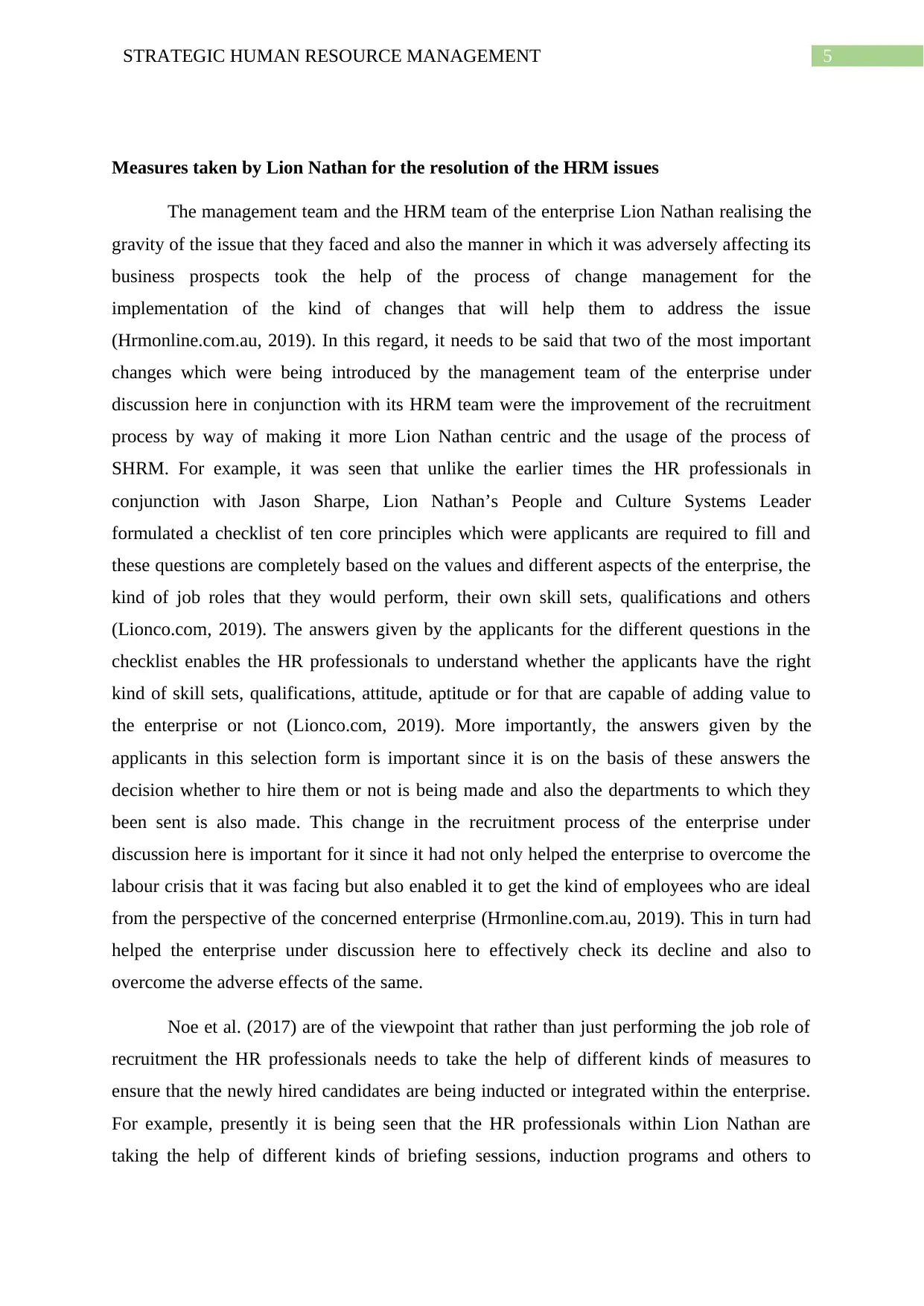
5STRATEGIC HUMAN RESOURCE MANAGEMENT
Measures taken by Lion Nathan for the resolution of the HRM issues
The management team and the HRM team of the enterprise Lion Nathan realising the
gravity of the issue that they faced and also the manner in which it was adversely affecting its
business prospects took the help of the process of change management for the
implementation of the kind of changes that will help them to address the issue
(Hrmonline.com.au, 2019). In this regard, it needs to be said that two of the most important
changes which were being introduced by the management team of the enterprise under
discussion here in conjunction with its HRM team were the improvement of the recruitment
process by way of making it more Lion Nathan centric and the usage of the process of
SHRM. For example, it was seen that unlike the earlier times the HR professionals in
conjunction with Jason Sharpe, Lion Nathan’s People and Culture Systems Leader
formulated a checklist of ten core principles which were applicants are required to fill and
these questions are completely based on the values and different aspects of the enterprise, the
kind of job roles that they would perform, their own skill sets, qualifications and others
(Lionco.com, 2019). The answers given by the applicants for the different questions in the
checklist enables the HR professionals to understand whether the applicants have the right
kind of skill sets, qualifications, attitude, aptitude or for that are capable of adding value to
the enterprise or not (Lionco.com, 2019). More importantly, the answers given by the
applicants in this selection form is important since it is on the basis of these answers the
decision whether to hire them or not is being made and also the departments to which they
been sent is also made. This change in the recruitment process of the enterprise under
discussion here is important for it since it had not only helped the enterprise to overcome the
labour crisis that it was facing but also enabled it to get the kind of employees who are ideal
from the perspective of the concerned enterprise (Hrmonline.com.au, 2019). This in turn had
helped the enterprise under discussion here to effectively check its decline and also to
overcome the adverse effects of the same.
Noe et al. (2017) are of the viewpoint that rather than just performing the job role of
recruitment the HR professionals needs to take the help of different kinds of measures to
ensure that the newly hired candidates are being inducted or integrated within the enterprise.
For example, presently it is being seen that the HR professionals within Lion Nathan are
taking the help of different kinds of briefing sessions, induction programs and others to
Measures taken by Lion Nathan for the resolution of the HRM issues
The management team and the HRM team of the enterprise Lion Nathan realising the
gravity of the issue that they faced and also the manner in which it was adversely affecting its
business prospects took the help of the process of change management for the
implementation of the kind of changes that will help them to address the issue
(Hrmonline.com.au, 2019). In this regard, it needs to be said that two of the most important
changes which were being introduced by the management team of the enterprise under
discussion here in conjunction with its HRM team were the improvement of the recruitment
process by way of making it more Lion Nathan centric and the usage of the process of
SHRM. For example, it was seen that unlike the earlier times the HR professionals in
conjunction with Jason Sharpe, Lion Nathan’s People and Culture Systems Leader
formulated a checklist of ten core principles which were applicants are required to fill and
these questions are completely based on the values and different aspects of the enterprise, the
kind of job roles that they would perform, their own skill sets, qualifications and others
(Lionco.com, 2019). The answers given by the applicants for the different questions in the
checklist enables the HR professionals to understand whether the applicants have the right
kind of skill sets, qualifications, attitude, aptitude or for that are capable of adding value to
the enterprise or not (Lionco.com, 2019). More importantly, the answers given by the
applicants in this selection form is important since it is on the basis of these answers the
decision whether to hire them or not is being made and also the departments to which they
been sent is also made. This change in the recruitment process of the enterprise under
discussion here is important for it since it had not only helped the enterprise to overcome the
labour crisis that it was facing but also enabled it to get the kind of employees who are ideal
from the perspective of the concerned enterprise (Hrmonline.com.au, 2019). This in turn had
helped the enterprise under discussion here to effectively check its decline and also to
overcome the adverse effects of the same.
Noe et al. (2017) are of the viewpoint that rather than just performing the job role of
recruitment the HR professionals needs to take the help of different kinds of measures to
ensure that the newly hired candidates are being inducted or integrated within the enterprise.
For example, presently it is being seen that the HR professionals within Lion Nathan are
taking the help of different kinds of briefing sessions, induction programs and others to
⊘ This is a preview!⊘
Do you want full access?
Subscribe today to unlock all pages.

Trusted by 1+ million students worldwide
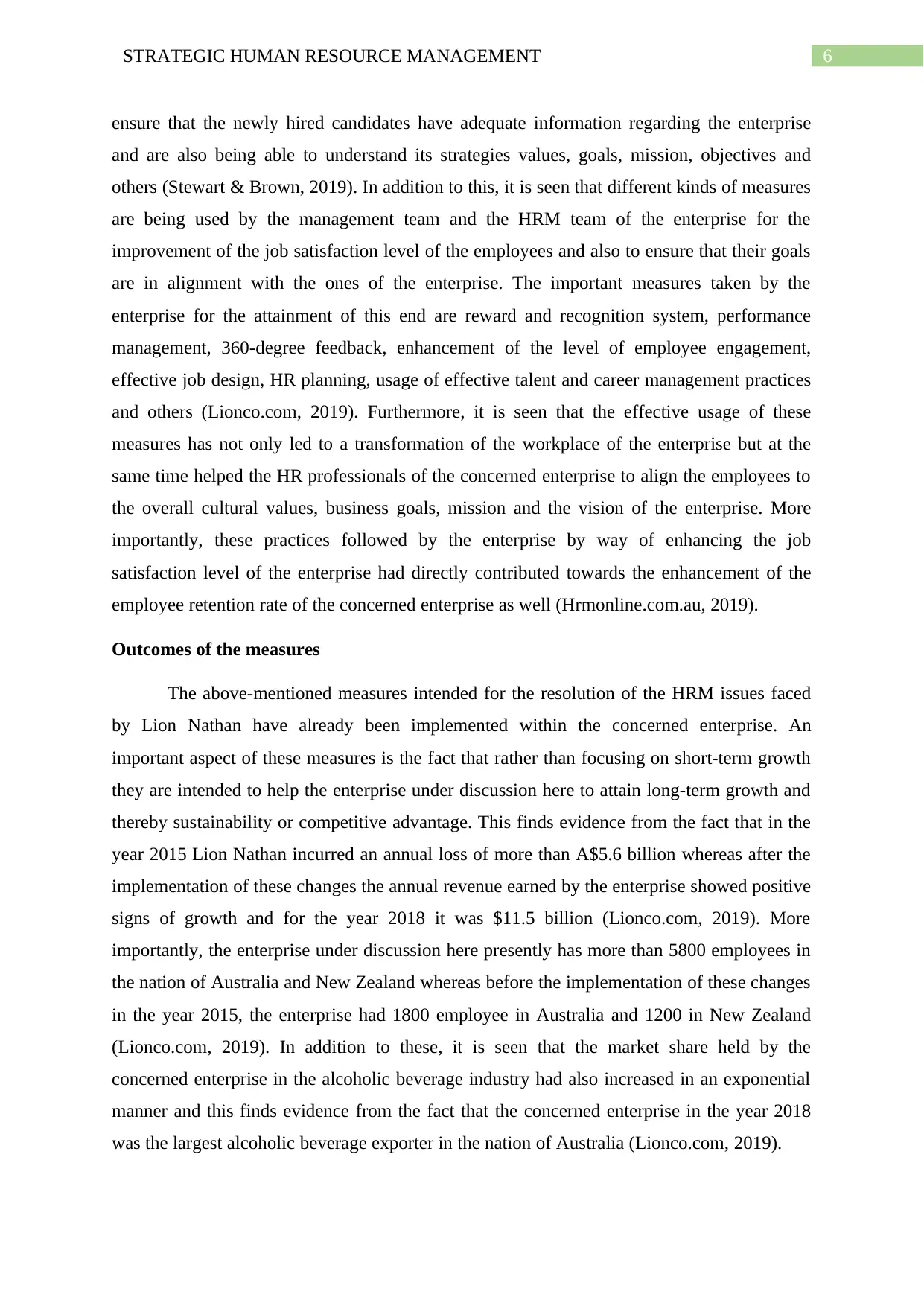
6STRATEGIC HUMAN RESOURCE MANAGEMENT
ensure that the newly hired candidates have adequate information regarding the enterprise
and are also being able to understand its strategies values, goals, mission, objectives and
others (Stewart & Brown, 2019). In addition to this, it is seen that different kinds of measures
are being used by the management team and the HRM team of the enterprise for the
improvement of the job satisfaction level of the employees and also to ensure that their goals
are in alignment with the ones of the enterprise. The important measures taken by the
enterprise for the attainment of this end are reward and recognition system, performance
management, 360-degree feedback, enhancement of the level of employee engagement,
effective job design, HR planning, usage of effective talent and career management practices
and others (Lionco.com, 2019). Furthermore, it is seen that the effective usage of these
measures has not only led to a transformation of the workplace of the enterprise but at the
same time helped the HR professionals of the concerned enterprise to align the employees to
the overall cultural values, business goals, mission and the vision of the enterprise. More
importantly, these practices followed by the enterprise by way of enhancing the job
satisfaction level of the enterprise had directly contributed towards the enhancement of the
employee retention rate of the concerned enterprise as well (Hrmonline.com.au, 2019).
Outcomes of the measures
The above-mentioned measures intended for the resolution of the HRM issues faced
by Lion Nathan have already been implemented within the concerned enterprise. An
important aspect of these measures is the fact that rather than focusing on short-term growth
they are intended to help the enterprise under discussion here to attain long-term growth and
thereby sustainability or competitive advantage. This finds evidence from the fact that in the
year 2015 Lion Nathan incurred an annual loss of more than A$5.6 billion whereas after the
implementation of these changes the annual revenue earned by the enterprise showed positive
signs of growth and for the year 2018 it was $11.5 billion (Lionco.com, 2019). More
importantly, the enterprise under discussion here presently has more than 5800 employees in
the nation of Australia and New Zealand whereas before the implementation of these changes
in the year 2015, the enterprise had 1800 employee in Australia and 1200 in New Zealand
(Lionco.com, 2019). In addition to these, it is seen that the market share held by the
concerned enterprise in the alcoholic beverage industry had also increased in an exponential
manner and this finds evidence from the fact that the concerned enterprise in the year 2018
was the largest alcoholic beverage exporter in the nation of Australia (Lionco.com, 2019).
ensure that the newly hired candidates have adequate information regarding the enterprise
and are also being able to understand its strategies values, goals, mission, objectives and
others (Stewart & Brown, 2019). In addition to this, it is seen that different kinds of measures
are being used by the management team and the HRM team of the enterprise for the
improvement of the job satisfaction level of the employees and also to ensure that their goals
are in alignment with the ones of the enterprise. The important measures taken by the
enterprise for the attainment of this end are reward and recognition system, performance
management, 360-degree feedback, enhancement of the level of employee engagement,
effective job design, HR planning, usage of effective talent and career management practices
and others (Lionco.com, 2019). Furthermore, it is seen that the effective usage of these
measures has not only led to a transformation of the workplace of the enterprise but at the
same time helped the HR professionals of the concerned enterprise to align the employees to
the overall cultural values, business goals, mission and the vision of the enterprise. More
importantly, these practices followed by the enterprise by way of enhancing the job
satisfaction level of the enterprise had directly contributed towards the enhancement of the
employee retention rate of the concerned enterprise as well (Hrmonline.com.au, 2019).
Outcomes of the measures
The above-mentioned measures intended for the resolution of the HRM issues faced
by Lion Nathan have already been implemented within the concerned enterprise. An
important aspect of these measures is the fact that rather than focusing on short-term growth
they are intended to help the enterprise under discussion here to attain long-term growth and
thereby sustainability or competitive advantage. This finds evidence from the fact that in the
year 2015 Lion Nathan incurred an annual loss of more than A$5.6 billion whereas after the
implementation of these changes the annual revenue earned by the enterprise showed positive
signs of growth and for the year 2018 it was $11.5 billion (Lionco.com, 2019). More
importantly, the enterprise under discussion here presently has more than 5800 employees in
the nation of Australia and New Zealand whereas before the implementation of these changes
in the year 2015, the enterprise had 1800 employee in Australia and 1200 in New Zealand
(Lionco.com, 2019). In addition to these, it is seen that the market share held by the
concerned enterprise in the alcoholic beverage industry had also increased in an exponential
manner and this finds evidence from the fact that the concerned enterprise in the year 2018
was the largest alcoholic beverage exporter in the nation of Australia (Lionco.com, 2019).
Paraphrase This Document
Need a fresh take? Get an instant paraphrase of this document with our AI Paraphraser
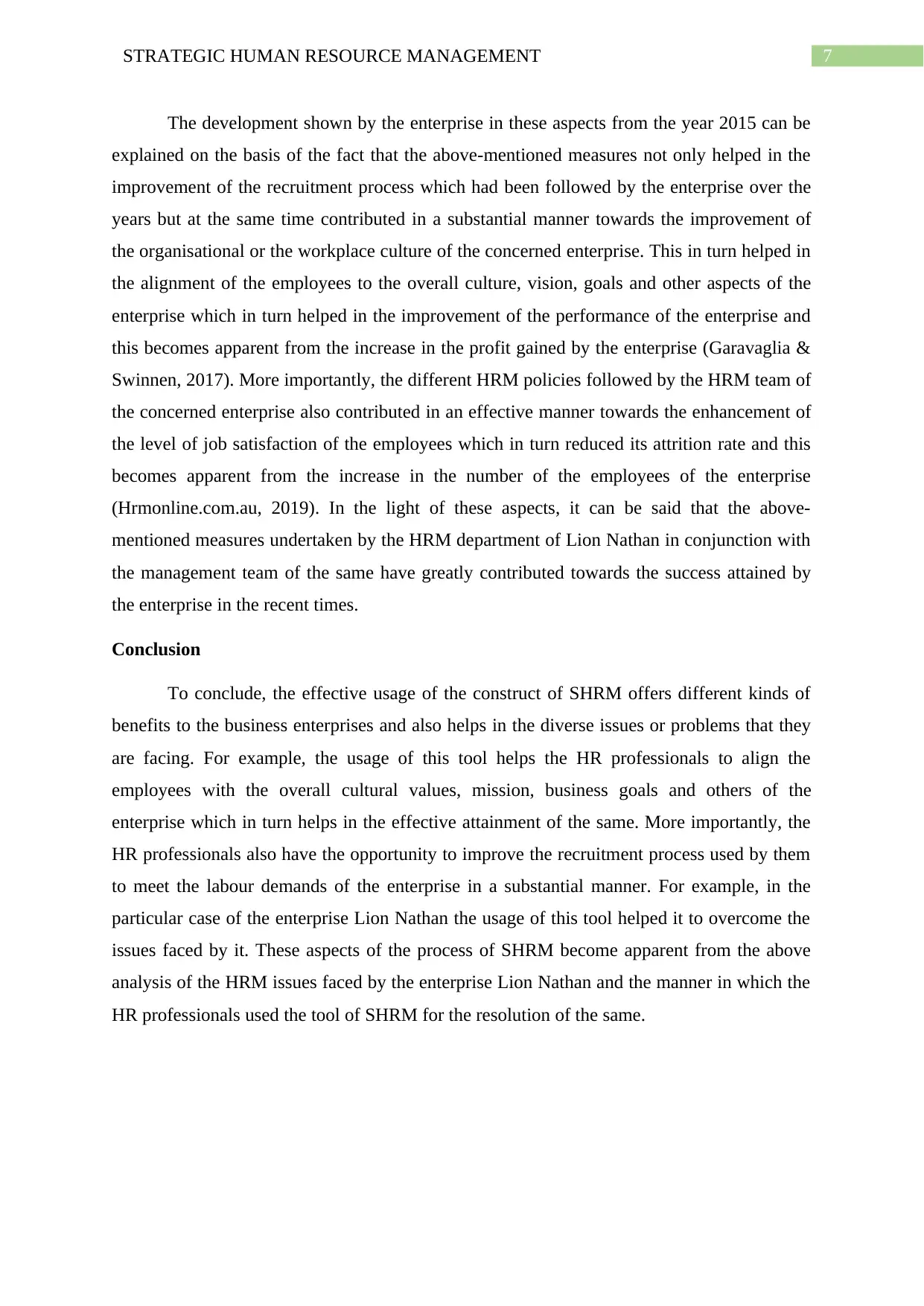
7STRATEGIC HUMAN RESOURCE MANAGEMENT
The development shown by the enterprise in these aspects from the year 2015 can be
explained on the basis of the fact that the above-mentioned measures not only helped in the
improvement of the recruitment process which had been followed by the enterprise over the
years but at the same time contributed in a substantial manner towards the improvement of
the organisational or the workplace culture of the concerned enterprise. This in turn helped in
the alignment of the employees to the overall culture, vision, goals and other aspects of the
enterprise which in turn helped in the improvement of the performance of the enterprise and
this becomes apparent from the increase in the profit gained by the enterprise (Garavaglia &
Swinnen, 2017). More importantly, the different HRM policies followed by the HRM team of
the concerned enterprise also contributed in an effective manner towards the enhancement of
the level of job satisfaction of the employees which in turn reduced its attrition rate and this
becomes apparent from the increase in the number of the employees of the enterprise
(Hrmonline.com.au, 2019). In the light of these aspects, it can be said that the above-
mentioned measures undertaken by the HRM department of Lion Nathan in conjunction with
the management team of the same have greatly contributed towards the success attained by
the enterprise in the recent times.
Conclusion
To conclude, the effective usage of the construct of SHRM offers different kinds of
benefits to the business enterprises and also helps in the diverse issues or problems that they
are facing. For example, the usage of this tool helps the HR professionals to align the
employees with the overall cultural values, mission, business goals and others of the
enterprise which in turn helps in the effective attainment of the same. More importantly, the
HR professionals also have the opportunity to improve the recruitment process used by them
to meet the labour demands of the enterprise in a substantial manner. For example, in the
particular case of the enterprise Lion Nathan the usage of this tool helped it to overcome the
issues faced by it. These aspects of the process of SHRM become apparent from the above
analysis of the HRM issues faced by the enterprise Lion Nathan and the manner in which the
HR professionals used the tool of SHRM for the resolution of the same.
The development shown by the enterprise in these aspects from the year 2015 can be
explained on the basis of the fact that the above-mentioned measures not only helped in the
improvement of the recruitment process which had been followed by the enterprise over the
years but at the same time contributed in a substantial manner towards the improvement of
the organisational or the workplace culture of the concerned enterprise. This in turn helped in
the alignment of the employees to the overall culture, vision, goals and other aspects of the
enterprise which in turn helped in the improvement of the performance of the enterprise and
this becomes apparent from the increase in the profit gained by the enterprise (Garavaglia &
Swinnen, 2017). More importantly, the different HRM policies followed by the HRM team of
the concerned enterprise also contributed in an effective manner towards the enhancement of
the level of job satisfaction of the employees which in turn reduced its attrition rate and this
becomes apparent from the increase in the number of the employees of the enterprise
(Hrmonline.com.au, 2019). In the light of these aspects, it can be said that the above-
mentioned measures undertaken by the HRM department of Lion Nathan in conjunction with
the management team of the same have greatly contributed towards the success attained by
the enterprise in the recent times.
Conclusion
To conclude, the effective usage of the construct of SHRM offers different kinds of
benefits to the business enterprises and also helps in the diverse issues or problems that they
are facing. For example, the usage of this tool helps the HR professionals to align the
employees with the overall cultural values, mission, business goals and others of the
enterprise which in turn helps in the effective attainment of the same. More importantly, the
HR professionals also have the opportunity to improve the recruitment process used by them
to meet the labour demands of the enterprise in a substantial manner. For example, in the
particular case of the enterprise Lion Nathan the usage of this tool helped it to overcome the
issues faced by it. These aspects of the process of SHRM become apparent from the above
analysis of the HRM issues faced by the enterprise Lion Nathan and the manner in which the
HR professionals used the tool of SHRM for the resolution of the same.
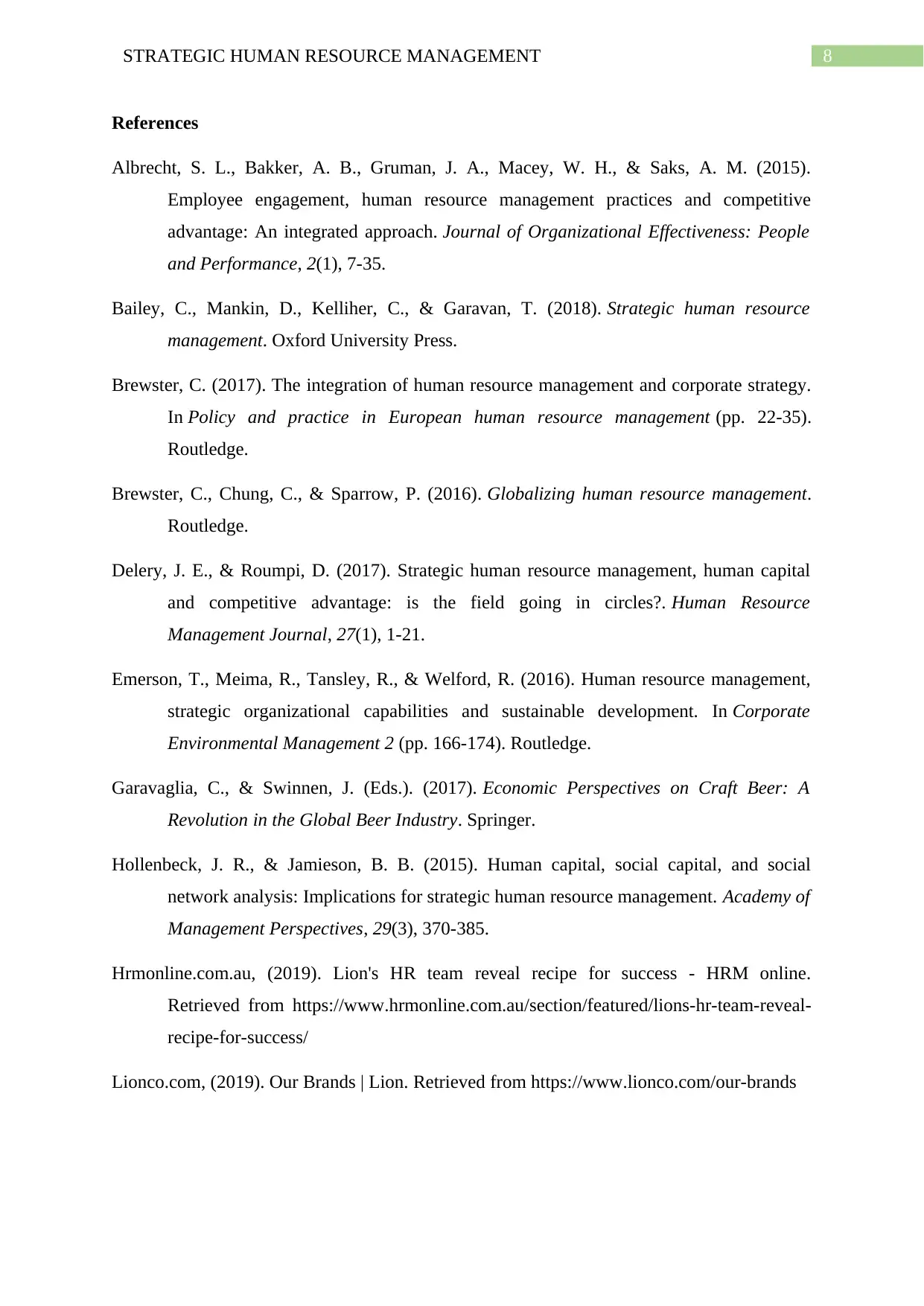
8STRATEGIC HUMAN RESOURCE MANAGEMENT
References
Albrecht, S. L., Bakker, A. B., Gruman, J. A., Macey, W. H., & Saks, A. M. (2015).
Employee engagement, human resource management practices and competitive
advantage: An integrated approach. Journal of Organizational Effectiveness: People
and Performance, 2(1), 7-35.
Bailey, C., Mankin, D., Kelliher, C., & Garavan, T. (2018). Strategic human resource
management. Oxford University Press.
Brewster, C. (2017). The integration of human resource management and corporate strategy.
In Policy and practice in European human resource management (pp. 22-35).
Routledge.
Brewster, C., Chung, C., & Sparrow, P. (2016). Globalizing human resource management.
Routledge.
Delery, J. E., & Roumpi, D. (2017). Strategic human resource management, human capital
and competitive advantage: is the field going in circles?. Human Resource
Management Journal, 27(1), 1-21.
Emerson, T., Meima, R., Tansley, R., & Welford, R. (2016). Human resource management,
strategic organizational capabilities and sustainable development. In Corporate
Environmental Management 2 (pp. 166-174). Routledge.
Garavaglia, C., & Swinnen, J. (Eds.). (2017). Economic Perspectives on Craft Beer: A
Revolution in the Global Beer Industry. Springer.
Hollenbeck, J. R., & Jamieson, B. B. (2015). Human capital, social capital, and social
network analysis: Implications for strategic human resource management. Academy of
Management Perspectives, 29(3), 370-385.
Hrmonline.com.au, (2019). Lion's HR team reveal recipe for success - HRM online.
Retrieved from https://www.hrmonline.com.au/section/featured/lions-hr-team-reveal-
recipe-for-success/
Lionco.com, (2019). Our Brands | Lion. Retrieved from https://www.lionco.com/our-brands
References
Albrecht, S. L., Bakker, A. B., Gruman, J. A., Macey, W. H., & Saks, A. M. (2015).
Employee engagement, human resource management practices and competitive
advantage: An integrated approach. Journal of Organizational Effectiveness: People
and Performance, 2(1), 7-35.
Bailey, C., Mankin, D., Kelliher, C., & Garavan, T. (2018). Strategic human resource
management. Oxford University Press.
Brewster, C. (2017). The integration of human resource management and corporate strategy.
In Policy and practice in European human resource management (pp. 22-35).
Routledge.
Brewster, C., Chung, C., & Sparrow, P. (2016). Globalizing human resource management.
Routledge.
Delery, J. E., & Roumpi, D. (2017). Strategic human resource management, human capital
and competitive advantage: is the field going in circles?. Human Resource
Management Journal, 27(1), 1-21.
Emerson, T., Meima, R., Tansley, R., & Welford, R. (2016). Human resource management,
strategic organizational capabilities and sustainable development. In Corporate
Environmental Management 2 (pp. 166-174). Routledge.
Garavaglia, C., & Swinnen, J. (Eds.). (2017). Economic Perspectives on Craft Beer: A
Revolution in the Global Beer Industry. Springer.
Hollenbeck, J. R., & Jamieson, B. B. (2015). Human capital, social capital, and social
network analysis: Implications for strategic human resource management. Academy of
Management Perspectives, 29(3), 370-385.
Hrmonline.com.au, (2019). Lion's HR team reveal recipe for success - HRM online.
Retrieved from https://www.hrmonline.com.au/section/featured/lions-hr-team-reveal-
recipe-for-success/
Lionco.com, (2019). Our Brands | Lion. Retrieved from https://www.lionco.com/our-brands
⊘ This is a preview!⊘
Do you want full access?
Subscribe today to unlock all pages.

Trusted by 1+ million students worldwide
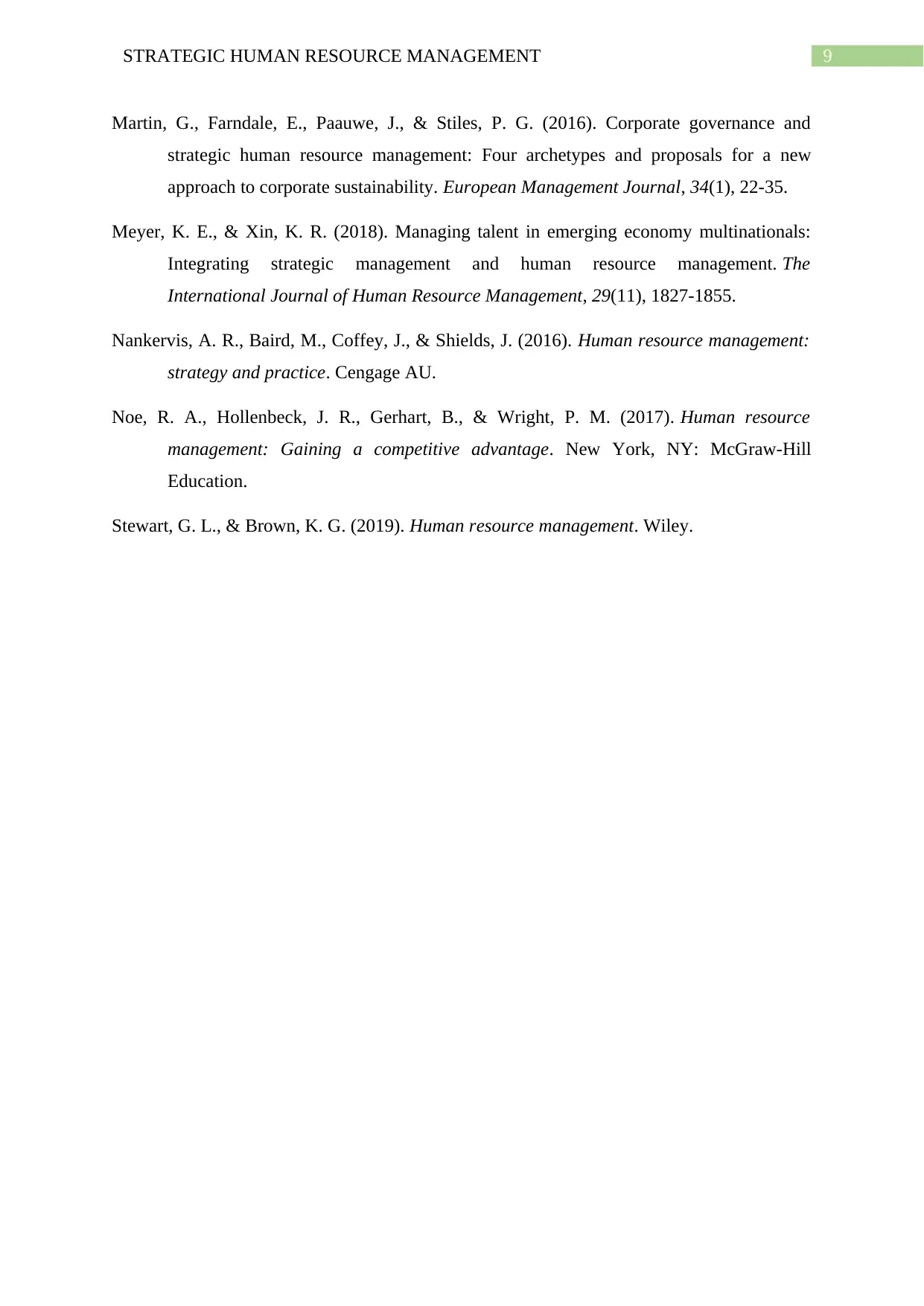
9STRATEGIC HUMAN RESOURCE MANAGEMENT
Martin, G., Farndale, E., Paauwe, J., & Stiles, P. G. (2016). Corporate governance and
strategic human resource management: Four archetypes and proposals for a new
approach to corporate sustainability. European Management Journal, 34(1), 22-35.
Meyer, K. E., & Xin, K. R. (2018). Managing talent in emerging economy multinationals:
Integrating strategic management and human resource management. The
International Journal of Human Resource Management, 29(11), 1827-1855.
Nankervis, A. R., Baird, M., Coffey, J., & Shields, J. (2016). Human resource management:
strategy and practice. Cengage AU.
Noe, R. A., Hollenbeck, J. R., Gerhart, B., & Wright, P. M. (2017). Human resource
management: Gaining a competitive advantage. New York, NY: McGraw-Hill
Education.
Stewart, G. L., & Brown, K. G. (2019). Human resource management. Wiley.
Martin, G., Farndale, E., Paauwe, J., & Stiles, P. G. (2016). Corporate governance and
strategic human resource management: Four archetypes and proposals for a new
approach to corporate sustainability. European Management Journal, 34(1), 22-35.
Meyer, K. E., & Xin, K. R. (2018). Managing talent in emerging economy multinationals:
Integrating strategic management and human resource management. The
International Journal of Human Resource Management, 29(11), 1827-1855.
Nankervis, A. R., Baird, M., Coffey, J., & Shields, J. (2016). Human resource management:
strategy and practice. Cengage AU.
Noe, R. A., Hollenbeck, J. R., Gerhart, B., & Wright, P. M. (2017). Human resource
management: Gaining a competitive advantage. New York, NY: McGraw-Hill
Education.
Stewart, G. L., & Brown, K. G. (2019). Human resource management. Wiley.
1 out of 10
Related Documents
Your All-in-One AI-Powered Toolkit for Academic Success.
+13062052269
info@desklib.com
Available 24*7 on WhatsApp / Email
![[object Object]](/_next/static/media/star-bottom.7253800d.svg)
Unlock your academic potential
Copyright © 2020–2025 A2Z Services. All Rights Reserved. Developed and managed by ZUCOL.




